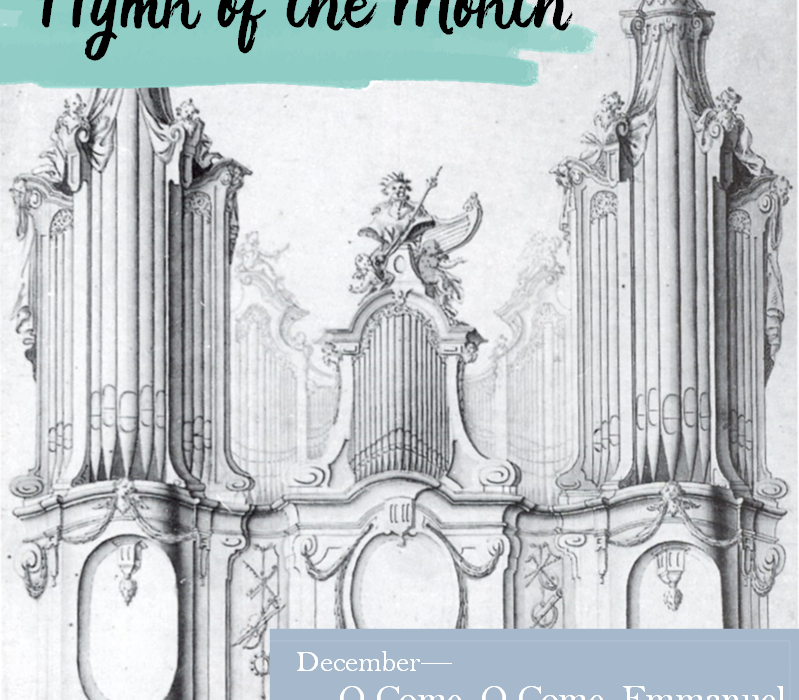Hymn of the Month
O Come, O Come, Emmanuel (LSB 357)
You have probably heard of an antiphon, but, who among us actually knows what that is? Well, for starters, quiz our kids who were confirmed last Easter—they have to review it every week! [Insert Sunday school teacher’s maniacal laugh]. But really, who else would know?
I shall tell you.
The Greek roots anti (“in place of”) and phonos (“voice”) give it away: it is when something is chanted back and forth. So for example, when we sing the introit at the beginning of the Divine Service, we sing it back and forth with the cantor, otherwise known as singing antiphonally. The antiphon as a ‘boldface term’ in church music refers specifically to the little liturgical text that frames (precedes and/or follows) a psalm or canticle. So, going back to our introit example, the first and last verse of the introit are the antiphon.
Our hymn this month comes from the seven “Great O Antiphons,” one for each of the seven days leading up to Christmas. These medieval antiphons framed the Magnificat (Song of Mary) during the evening vespers on those nights. In using the antiphons in this way, the liturgy was colored with the emphases of the Advent, placing all the normal canticles and songs in the context of the coming Incarnation at Christmas.
They are called the “Great O Antiphons” because each one begins with… wait for it… “O”!
- December 17: O Sapientia (O Wisdom)
- December 18: O Adonai (O Lord)
- December 19: O Radix Jesse (O Root of Jesse)
- December 20: O Clavis David (O Key of David)
- December 21: O Oriens (O Dayspring)
- December 22: O Rex Gentium (O King of the Nations)
- December 23: O Emmanuel (O “God with us”)
Each of these antiphons is a prayer addressed to the Son of God, with each invoking Him based on His titles in the Old Testament:
Christ is called “Wisdom” throughout the Proverbs, and explicitly by Paul in 1 Corinthians 1:24. Adonai is the Hebrew title (meaning “Lord”) that was often substituted for “Yahweh,” so as not to take the name of the Lord lightly. This Old Testament name draws us back to God’s appearance to Moses in the burning bush, and all through the Exodus of the Israelites from Egypt. “Root of Jesse” comes from the prophetic promise of Isaiah 11:10, wherein Jesus’ royal lineage from King David is foretold (Jesse was David’s father). That royal theme is reiterated in the next antiphon, using the title “Key of David” from Revelation 3:7 to look forward to the Last Day, when Christ shall unlock the door of heaven to all who are in Him. “Dayspring” is language from Zechariah’s song, the Benedictus (Luke 1:78-79; Isaiah 9:1, 5-6); Zechariah was the father of John the Baptist, and his song speaks of “the Dayspring from on high [that] hath visited us, to give light to them that sit in darkness and in the shadow of death.” “Desire of Nations” comes from the prophet Haggai (2:7, 9), wherein it is foretold that the Lord will fulfill the desire of all nations in His coming, a coming which realizes the peace of man with God. Lastly, we call upon “Emmanuel,” a Hebrew name which means “God with us.” Truly, with the Christchild’s birth, God has come to dwell with man, in our own flesh, and shall never be parted from us.
With these ancient names, we see Jesus unifying all of the Old Testament in Himself, coming as the ultimate fulfillment of all that was promised from the beginning of time. In the hymn, we take on the identity of the house of Israel, an allusion to the Church throughout all ages. And in that same longing tone with which the prophets cried out for God’s coming, we too plead with Him to dwell among us as Emmanuel, God with us.
Rejoice, you who wait and sing these words. For He has come to you, O Israel.
Fun Fact: Those medieval monks weren’t all work and no play! In fact, they were rather clever… just humor me. In the Latin, if you take the beginning letter of each name (excluding the “O,” of course), you get a rather nonsensical word: SARCORE. Buuut, if you read that word backwards, you get ERO CRAS, which is Latin for “tomorrow I will be present.” With the last of our antiphons being sung on December 23rd, this was taken as a “secret” message of the Eve of the Nativity coming on the 24th.



